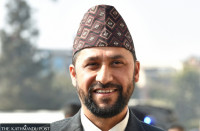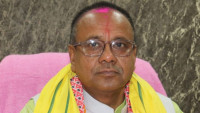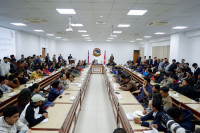National
Supreme Court summons editors over news reports. Not everyone is amused
Experts say court’s rebuttal of news suggesting a meeting between prime minister and chief justice is uncalled for and demanding proof from editors wrong.
Tika R Pradhan
When the hearing on Prime Minister KP Sharma Oli’s first House dissolution of December 20 was underway in the Supreme Court, reports surfaced in a section of online media that Justices Hari Krishna Karki and Sapana Pradhan Malla met the prime minister in the afternoon of January 10. Reports suggested that Justices Dipak Kumar Karki and Mira Khadka met with Oli in the evening for an hour the next day.
The case was being heard by the Constitutional Bench led by Justice Cholendra Shumsher Rana.
The Supreme Court on January 15 issued a statement, denying the justices’ meeting with the prime minister and saying the news reports were “fictitious” and “misleading” and they were far from the truth.
Warning that such news could adversely affect the integrity of the judiciary and public trust in the courts, the top court said dissemination of such news was “unfortunate”. It urged all not to be misled by such reports.
The online portals subsequently admitted that their sources had misled them and they removed the news.
The Supreme Court then was under tremendous pressure, as the entire country was watching. Experts on constitutional affairs had called Oli’s House dissolution an out and out unconstitutional move. Four former chief justices in a joint statement had said that the Constitution of Nepal doesn’t allow the KP Sharma Oli government to dissolve the House of Representatives.
In Nepal, people have always put immense faith in the judiciary, but Oli’s House dissolution had thrown the rumour mill into an overdrive. Talks were rife that Oli had managed to influence the court, something if true would dismantle the principle of the separation of powers.
Amid such speculations, the Supreme Court’s reaction to the news reports was seen as a valid move, as the administration could have felt it necessary to dispel rumours.
The Supreme Court on February 23 overturned Oli’s House dissolution and restored the House.
But on Friday, Oli once again dissolved it. His move has been challenged in the Supreme Court again.
Amid this, at least two media outlets, imagekhabar.com and nepalsamaya.com, ran news reports, claiming that Oli held an hour-long meeting with Chief Justice Rana on Monday midnight. The reports suggested, quoting anonymous sources, Oli had asked Rana to support him.
The Supreme Court reacted.
“The mentioned subject [in the news] has no basis of truth and it is extremely saddening and condemnable that such an exaggerated news report was published with malafide intentions to adversely affect the fairness of the judiciary and the faith and trust in it,” states the press release signed by Devendra Dhakal, joint spokesperson of the Supreme Court. “Since such acts are against the constitution, law and code of conduct of journalists, we would like to caution that such acts could attract legal actions.”
The statement also called on all concerned to correct such “baseless, fictitious and misleading” reports that affect the dignity and esteem of the judiciary.
The court administration even summoned the editors of the two news portals to what it said was “discuss” the matter.
Experts say any party, if felt aggrieved by news stories, can refute stories through statements, but they say the Supreme Court appears to have overreacted.
“If the chief justice had not met with anyone, that’s fine. I don’t see a need to make a hue and cry,” said Balaram KC, a former Supreme Court justice. “If the chief justice indeed had met with the prime minister, it is highly objectionable.”
According to KC, the judiciary is like a house of glass and its strength lies in people’s trust.
“It’s up to the authorities of the judiciary to maintain its sanctity. They should follow the code of conduct and demonstrate a high moral ground so that no one gets an opportunity to raise their finger at it,” said KC.
Last time when the House dissolution case was pending, the court was quick to accept contempt of court cases against the four former chief justices who had pointed out that the government’s move was unconstitutional. The four former chief justices duly appeared before the court to furnish their clarification, in what was described as the beauty of the democratic and judicial process.
According to experts and analysts, the one sector that has thrived after the restoration of democracy in Nepal is the media and its contribution to Nepal’s democtratic transitions has been hailed.
It’s not that Nepal’s media sector does not have problems and that it needs to improve a lot, but analysts say, problems are in every sector. Nepali media has always been at the forefront of exposing policy corruptions and political wrongdoings and has even dared to point at the wrongs within the judiciary.
“If there was no meeting, then there was no need to issue a justification,” said KC. “The court should first have belief in itself that it maintains the highest level of independence and integrity. Its actions should show that, not statements.”
The code of conduct for Nepal’s justices bars them from meeting people who are party to any case that is being heard by the court.
Even if the chief justice and the prime minister were brothers, they should not meet except on formal occasions, according to KC.
Last year, Oli and Rana’s images were splashed on the media when they were seen leaning towards each other in what looked like a consultation. It, however, was a public function—inauguration of the new building of the Office of Attorney General—on December 23.
The likelihood of any close consultation was almost impossible at such a public gathering, but since the House dissolution case was pending at that time, the images raised quite an eyebrow.
The Supreme Court managed to dispel the rumours when it overturned Oli’s House dissolution after hearing the case continuously for two months. The judiciary received applause for upholding the rule of law.
However, two weeks later, in a dramatic verdict, it scrapped the Nepal Communist Party (NCP) and revived the CPN-UML and the Communist Party of Nepal (Maoist Centre). The verdict largely went in favour of Oli, who emerged even stronger, which is now evident from his second House dissolution.
Experts say by reacting to news reports, the court itself is sowing the seeds of doubt among the public.
“How many such releases will it issue if the media continues to write more reports,” said KC.
Legal experts have taken issue also with the court decision to summon journalists over news reports.
“And if the court has any objection to news reports, instead of issuing a press statement, it should have written to the Press Council Nepal, which is the appropriate body to lodge complaints,” said Om Prakash Aryal, an advocate. “Calling journalists over news reports is not a good practice. It is tantamount to threatening them.”
Shambhu Thapa, also a senior advocate, described the summoning of journalists to the court as the height of insensitiveness on the part of the court administration.
“There is an institution called Press Council Nepal,” said Thapa. “The institution has been set up to look into matters related to the media.”
A court official, who did not wish to be named, however, said the Press Council Nepal is just a quasi-judicial body.
“How can the Supreme Court go to a quasi-judicial body to file a complaint?” said the official.
The two journalists who were summoned by the court are Rajan Kuikel of imagekhabar.com and Narayan Amrit of nepalsamaya.com.
“We were told to disclose our news sources and apologise for the news reports,” said Kuikel, editor of imagekhabar.com. “But we refused and asked them to follow the due procedure and file a complaint at the Press Council of Nepal if they deem our stories inaccurate.”
According to Kuikel, Narayan Panthi, the registrar of the Supreme Court, had asked them to show the basis for their reports.
“But we said everything is in the news and we stand by our reports,” Amrit told the Post.
Ramesh Bista and Roshan Puri, senior vice-chair and general secretary of the Federation of Nepali Journalists, were also present during the court registrar’s discussions with the two editors.
The federation, the umbrella organisation of journalists in Nepal, later in the day issued a statement.
“There is an established procedure to seek legal recourse if anyone has complaints about the published news materials,” read the statement issued by Puri. “Interrogation of journalists by the supreme body of the judiciary goes against the spirit of the constitution, which guarantees full press freedom.”
The preamble of the constitution says “we the sovereign people of Nepal…. being committed to… full freedom of the press, and independent, impartial and competent judiciary and concept of the rule of law… do hereby pass and promulgate this Constitution.”
In a statement later in the day, the Online Journalists’ Association also objected to the summoning of editors by the court administration.
“The Supreme Court administration must be well aware of the fact that there are certain procedures for legal redressal if there are complaints and concerns about published news materials,” the association said. “We object to the summoning of the editors in the name of discussing the matters published in their portals.”
Kishor Poudel, a communication expert at the Supreme Court, said the court administration asked the editors to provide the basis for their news reports and prove their reports were accurate.
“We asked them to put out a corrigendum with an apology if they cannot prove their stories are accurate, as baseless reports affect the integrity and independence of the judiciary,” Poudel told the Post. “We have not asked the editors to disclose their sources.”
Legal experts say that by issuing a press statement instead of seeking an appropriate legal route to refute the news reports, the judiciary has created confusion among the people, making them wonder if the apex court is trying to cover something up.
According to KC, the former justice, in third world countries like Nepal, there is a tendency among politicians to preach the independence of judiciary and freedom of press only before coming to power.
“The judiciary is supposed to protect the freedom of press,” said KC. “It cannot create a scary environment for the media.”




 17.12°C Kathmandu
17.12°C Kathmandu















